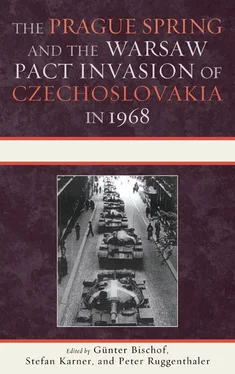In 1967, the demarcation line that separated the inimical camps within the KSČ leadership became apparent: those who supported a continuation and intensification of the reforms and those under Novotný’s aegis who, motivated by fear of further progress, opted for indecisive and incomplete solutions. However, at the crucial moment toward the end of the year there were a number of additional fault lines which caused these forces within the Central Committee to split into opposing factions. There were those who joined the anti-Novotný camp for various personal reasons, and the Slovak question was another key factor. Novotný’s lack of sensitivity in handling Slovak matters and Slovakia’s declared wish to be granted a certain maneuvering space at the expense of strict central control resulted in a Slovak front practically unified against Novotný. By another paradoxical twist, one of the protagonists in the activities that led to Novotný’s dismissal, Vasil Bil’ak, was to assume a leading role a few months later in a plot that staged a coup in the KSČ with Moscow’s help and engaged in preparations for the military invasion of Czechoslovakia.
Some of the measures adopted by the new party leadership after January 1968 were merely designed to reduce further the standing of Novotný and his supporters and, therefore, lacked the logic of a consistent reform program. The key decision at the end of February 1968 to abolish censorship must be seen in that context. This decision was taken in the illusory conviction that the party’s control of the media was guaranteed by the KSČ members being among the editors and that society could be counted on in its entirety to support the reform program and nothing else. This quickly proved a misjudgment. The media totally emancipated themselves from any control within weeks and assumed the role of one of the most important political actors. The nascent civil society and the critical public opinion generated demands that went much further than the planned reforms, which, moreover, had at least in part been conceived in an academic environment and were still far from having assumed the form of a concise political program.
Incidentally, the reformist movement within the KSČ did not achieve by any means a stable or fixed identity during the eight months of the Prague Spring, the time between Alexander Dubček’s acceptance of the party leadership and the intervention in August. It was itself in a state of flux; it accommodated a variety of different viewpoints, nuances, priorities, and a whole range of different assessments as to the envisaged scope of the reforms. It was, therefore, not highly developed in terms of its program nor even, for a long time, in terms of its membership. The line of demarcation between reformers and orthodox Communists that eventually split the KSČ leadership emerged slowly and by degrees. It did not imply radically different programmatic viewpoints; what set the camps apart was, rather, a difference in the way they represented their viewpoints in public and the attitudes they displayed toward the Warsaw Pact “allies.” For the reader of the minutes of the speeches delivered at the sessions of the KSČ’s governing bodies in April or May 1968, it is virtually impossible to tell which of the speakers would end up after the suppression of the Prague Spring with the tag “revisionist” and “opportunist” and which would be counted among the “healthy forces.” Utterances that are characteristic for us of the way the Kremlin viewed the situation in Czechoslovakia were voiced in the spring of 1968 not only by those members of the KSČ leadership who in the end threw in their lot with the “allies” of the Warsaw Pact and took part in preparing the intervention, but also (and on a fairly regular basis, too) by the protagonists of the reform movement. Dubček himself as well as the head of the government Oldřich Černík, the president of the National Assembly Josef Smrkovský, Central Committee Secretary Zdeněk Mlynář, and others routinely referred to the imminence of the counterrevolution, to the need to leave the people’s militias (the KSČ’s armed units) intact because it might become necessary to deploy them, to tanks and the use of force as extreme but, perhaps, inevitable possibilities. They, too, voiced regular complaints about the party’s increasing loss of control of the media and peremptorily demanded a change of this intolerable situation. They did mention, it is true, other things as well, such as the positive transformation program for which the party had to muster and retain public support. (The reasons given for this included the need not to concede terrain to “right-wing antisocialist forces.”) 10Above all, they used a somewhat different diction when their words were designed for public consumption. Yet it reflects to their credit that they were capable of heeding the mood and the expectations of the public, of respecting them and taking them into account. This was not necessarily due to their unprincipled, opportunist “Janus-headed politics” (epithets used later by the “normalized” KSČ leadership and the “normalized” media to characterize their approach), but is regarded as evidence of the increasing regeneration of society’s potential in the direction of an open society and a normal interaction between the public and the political elites. A situation characterized by almost complete freedom of speech and the restoration of public opinion was simply too propitious to be ignored. Dubček’s own position was somewhere in the middle. He tried to defuse extremist positions, he tacked and veered, and his increasing popularity was due primarily to his likable appearance, which did indeed set him apart from leading Communist functionaries both before and after him.
The mainstream of this reformist movement did not by any means advocate the abolition of the existing political and economic system. The goals were innovation, rationalization, increased productivity, and undoubtedly also a certain upgrading of the regime in humane terms. It is possible to document with some precision that this applied both to those who chiefly represented the reform movement—in a word, Dubček and his entourage—and to the majority within the KSČ at the time. Mlynář later estimated in his memoirs, which were first published in the West, 11that this group represented roughly 80 percent of the party. It was this reformist majority that emerged victorious in spring 1968 from the KSČ’s district and regional conferences and that would have triumphed at the extraordinary party conference scheduled for September, which never took place. The programmatic key document of the reformist movement, the so-called Action Program, which the KSČ leadership passed on 5 April 1968, displays a disconcerting lack of focus and considerable internal contradictions. 12There is, of course, no disputing that parts of the reformist program aimed for a far-reaching enfranchisement in the areas of culture and the sciences, for the removal of obstacles that hampered the professional careers of nonparty members, for a program of rehabilitation and compensation for the victims of injustice, and so forth. The same applies to the emphasis on the autonomy of the organs of the state (government, parliament, and regional and local authorities). The Communist Party’s task was perceived not to lie in day-to-day administration, but in the definition in political terms of the direction in which society was to move. This was, indeed, a striking innovation: the party was to resign its role of an omnipresent force that dominated everything, reducing all other social organizations and institutions to cogs and levers for the transmission of Communist power. Questions concerning political power and the admissibility of political pluralism were off limits. Should it ever become possible to address them, this would be in a distant future and in a manner that was far from clear in 1968. 13In simple terms, one could say that the reformers within the party leadership were not aiming for the democratization but for the liberalization of the system. It goes without saying that even this political course differed substantially from anything for which the KSČ had stood prior to 1968 and would stand for from 1969 onward. It was also a course that propelled Czechoslovakia, through the unplanned but nevertheless real synergy with the dynamics of an agitated social movement, beyond the confines of “really existing socialism.”
Читать дальше












